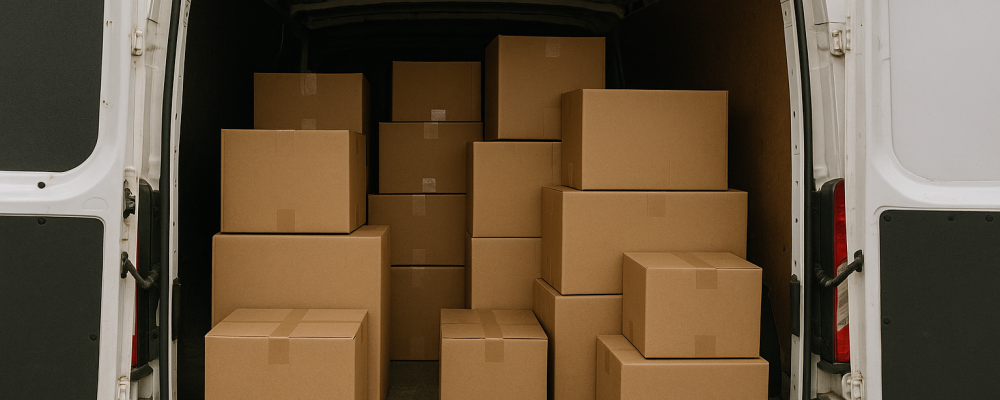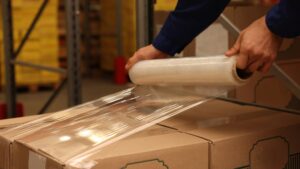Good packing has a direct impact on efficiency and reduced transport and storage costs, and for a variety of goods the benefits can be very significant. This problem is present in both manufacturing and logistics companies.
We suggest how to optimise loading space, what tools and strategies to use and how to reduce costs and environmental impact.
What is load space optimisation and why should it be implemented?
Cargo space optimisation is a process aimed at maximising the use of available space in transport units such as containers, pallets or trucks.
The key here is not only the efficient arrangement of goods, but also the selection of appropriate packaging materials to ensure the stability and safety of the products being transported.
Efficient packaging is the foundation of modern logistics. It reduces transport costs, shortens delivery times and reduces the use of packaging materials. A well-thought-out packaging process also translates into a lower risk of damage to goods, which means lower losses and greater satisfaction for end customers.
Impact of space optimisation on costs, logistics and the environment
In an era of increasing expectations of sustainability, companies are increasingly looking for solutions to operate efficiently and in an environmentally responsible manner.
In production companies, identical (homogeneous) packaging is often arranged, which allows a once-in-a-lifetime solution. In logistics companies, it is much more difficult, as a variety of packages have to be stacked and often do so on the fly (in real time), creating so-called heterogeneous loading units.
Efficient use of loading space translates directly into lower transport and storage costs. By transporting more goods at once, we reduce the number of trips, which means lower fuel consumption, less labour and shorter delivery times. This in turn improves the profitability of the logistics business and increases the competitiveness of the company.
Reducing the number of transports while keeping the same amount of goods also means optimising warehouse processes. Products can be stored in a more organised manner, resulting in better space management and reduced operating costs.

At the same time, cargo safety is improved – by reducing empty space, the risk of goods moving and possibly being damaged is reduced.
Another important consideration is the environmental impact. Reducing the number of transports and the consumption of packaging materials reduces the company’s carbon footprint.
Reducing greenhouse gas emissions and better management of resources is a response to the expectations of customers and business partners, who increasingly rely on working with socially responsible brands. Space optimisation is also part of strategic thinking about the company’s future.
Successful strategies for effective packaging - from planning to consolidation
The basis for effective packaging is careful planning of the layout of the load. As early as the order picking stage, it is worth analysing how the goods can be arranged on a pallet or in a container.
Dimensions, weight, shape and susceptibility to damage are taken into account. The right placement strategy maximises the use of space while ensuring the safety of the load.
Equally important is the choice of the right packaging materials – not only for packing the consignment, but also for securing it from the outside. A key role here is played by stretch film, which allows effective and flexible protection of the load without increasing its volume. Stretch film works well in a variety of industries – it is durable, damage-resistant and easy to use.
Become a member of our newsletter audience
Pallet loading calculator - support for optimisation
Manual load planning can be time-consuming and error-prone, which is why more and more companies are using tools to support this process. One such tool is the pallet loading calculator, which allows for quick and precise planning of load distribution in vehicles or containers.
A pallet loading calculator is a tool that automatically calculates the optimal distribution of pallets in a given load space. An example of such a solution is the Goodloading planner, LOGGY.co.uk or EasyCargo, which automatically arranges pallets on the selected loading space. Simply enter the dimensions of the load, the type of pallet and the parameters of the vehicle or container to obtain a ready-to-use loading plan.
Properly selected packaging material is one of the simplest and most effective ways to optimise space.
The use of standardised packaging sizes also influences packaging efficiency. By standardising the dimensions of crates, cartons or containers, it is possible to make the items fit better with each other and with the transport units. This minimises the amount of empty space and the entire packaging process becomes faster and more predictable.
A final but highly effective practice is the consolidation of loads. Combining smaller orders into larger transport units reduces the number of shipments and cuts costs. Especially in e-commerce and retail distribution, consolidation is essential to stay competitive and optimise logistics.
Benefit from Mac-Graf's experience - optimize your company's packaging process
If you are looking for proven solutions for optimising loading space and efficient packaging, contact us. We offer comprehensive support for logistics, manufacturing and e-commerce companies.
Our products and advice will help you reduce costs, increase operational efficiency and operate more sustainably.
Contact us today and see how we can help you optimise your company’s packaging processes.
We can help you and optimize the packaging process in your company
Make an appointment with our advisor

An experienced sales and customer service specialist, responsible for building strong partnerships both in Poland and abroad. He approaches his work with the same discipline and perseverance he developed on the basketball court as a former player for Astoria Bydgoszcz and Noteć Inowrocław. Today, he successfully blends the competitive spirit of an athlete with professional business acumen.









